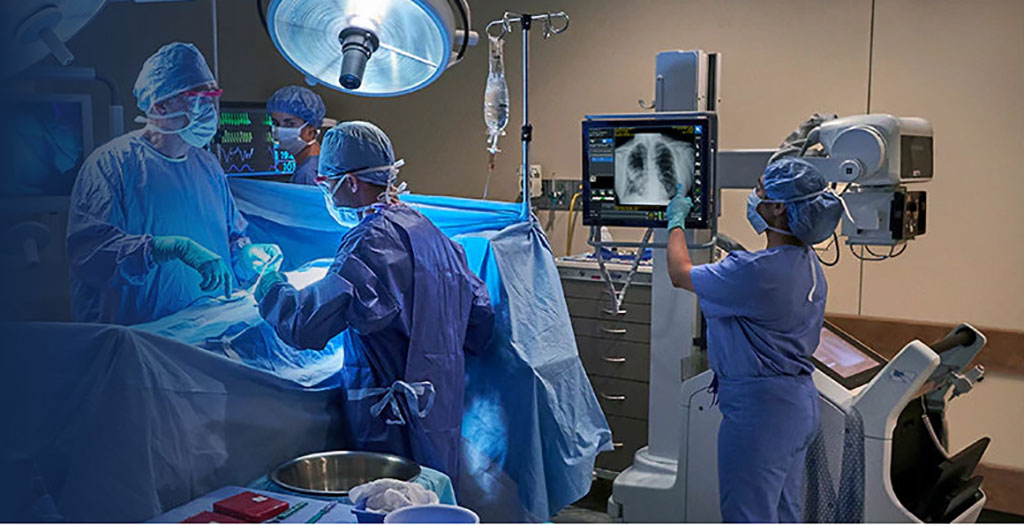GE Healthcare Launches First X-Ray AI Algorithm to Help Assess Endotracheal Tube Placement for COVID-19 Patients
By MedImaging International staff writers
Posted on 24 Nov 2020
GE Healthcare (Chicago, IL, USA) has launched a new artificial intelligence (AI) algorithm to help clinicians assess Endotracheal Tube (ETT) placements, a necessary and important step when ventilating critically ill COVID-19 patients.Posted on 24 Nov 2020
The AI solution is one of five included in GE Healthcare’s Critical Care Suite 2.02, an industry-first collection of AI algorithms embedded on a mobile x-ray device for automated measurements, case prioritization and quality control. Research shows that up to 25% of patients intubated outside of the operating room have misplaced ETTs on chest X-rays, which can lead to severe complications for patients, including hyperinflation, pneumothorax, cardiac arrest and death. Moreover, as COVID-19 cases climb, anywhere from 5-15% require intensive care surveillance and intubation for ventilatory support.

Illustration
Up to 45% of ICU patients, including severe COVID-19 cases, receive ETT intubation for ventilation. While proper ETT placement can be difficult, Critical Care Suite 2.0 uses AI to automatically detect ETTs in chest X-ray images and provides an accurate and automated measurement of ETT positioning to clinicians within seconds of image acquisition, right on the monitor of the x-ray system. In 94% of cases, the ET Tube tip-to-Carina distance calculation is accurate to within 1.0 cm. With these measurements, clinicians can determine if the ETT is placed correctly or if additional attention is required for proper placement. The AI generated measurements - along with an image overlay - are then made accessible in a picture archiving and communication systems (PACS).
Improper positioning of the ETT during intubation can lead to various complications, including a pneumothorax, a type of collapsed lung. While the chest X-ray images of a suspected pneumothorax patient are often marked “STAT,” they can sit waiting for up to eight hours for a radiologist’s review. However, when a patient is scanned on a device with Critical Care Suite 2.0, the system automatically analyzes images and sends an alert for cases with a suspected pneumothorax - along with the original chest X-ray - to the radiologist for review via PACS. The technologist also receives a subsequent on-device notification to provide awareness of the prioritized cases. To make the AI suite more accessible, Critical Care Suite 2.0 is embedded on a mobile X-ray device - offering hospitals an opportunity to try AI without making investments into additional IT infrastructure, security assessments or cybersecurity precautions for routing images offsite.
“The pandemic has proven what we already knew - that data, AI and connectivity are central to helping those on the front lines deliver intelligently efficient care,” said Jan Makela, President and CEO, Imaging at GE Healthcare. “GE Healthcare is not only providing new tools to help hospital staff keep up with demand without compromising diagnostic precision, but also leading the way on COVID-era advancements that will have a long-lasting impact on the industry, long after the pandemic ends.”
“In several COVID-19 patient cases, the pneumothorax AI algorithm has proved prophetic - accurately identifying pneumothoraces/barotrauma in intubated COVID-19 patients, flagging them to radiologist and radiology residents, and enabling expedited patient treatment,” said Dr. Amit Gupta, Modality Director of Diagnostic Radiography at University Hospital Cleveland Medical Center and Assistant Professor of Radiology at Case Western Reserve University, Cleveland. “Altogether, this technology is a game changer, helping us operate more efficiently as a practice, without compromising diagnostic precision. We soon will evaluate the new ETT placement AI algorithm, which we hope will be an equally valuable tool as we continue caring for critically ill COVID-19 patients.”














